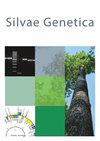利用新一代测序技术开发马来龙葵基因组DNA微卫星标记
IF 1
4区 农林科学
Q3 FORESTRY
引用次数: 1
摘要
摘要利用Illumina新一代测序技术(Next Generation Sequencing, Illumina),从菲律宾具有重要生态和经济价值的双龙科植物Parashorea malaanonan基因组DNA中开发出20个多态微卫星标记。利用一个自然种群的30棵成年树来评估PCR扩增的成功率和多态性程度。每个位点的等位基因数为3 ~ 13个,观察杂合度和期望杂合度分别为0.200 ~ 0.808和0.301 ~ 0.890。第一亲本和第二亲本在20个位点上的总排除概率分别为0.99932499和0.99999723。这些位点的高水平多态性使得对其遗传参数的精确估计成为可能,从而为马来酸楠的群体遗传学、保护遗传学和分子生态学的研究提供了依据。本文章由计算机程序翻译,如有差异,请以英文原文为准。
Development of microsatellite markers from genomic DNA of Parashorea malaanonan (Dipterocarpaceae) using next-generation sequencing
Abstract Twenty polymorphic microsatellite markers were developed, using Next Generation Sequencing (Illumina), from genomic DNA of Parashorea malaanonan, a species of the Dipterocarpaceae which is ecologically and economically important in the Philippines. Thirty adult trees from a natural population were used to assess the success of PCR amplification and the degree of polymorphism. The number of alleles per locus varied from three to 13, and observed and expected heterozygosity varied from 0.200 to 0.808 and from 0.301 to 0.890 respectively. Total exclusion probabilities for the first and second parents over the 20 loci were 0.99932499 and 0.99999723 respectively. The high level of polymorphism at these loci makes it possible to obtain precise estimates of genetic parameters and thus the markers will help in studies on population genetics, conservation genetics, and molecular ecology of P. malaanonan.
求助全文
通过发布文献求助,成功后即可免费获取论文全文。
去求助
来源期刊

Silvae Genetica
农林科学-林学
CiteScore
2.20
自引率
10.00%
发文量
10
审稿时长
3 months
期刊介绍:
Silvae Genetica is an international peer reviewed journal with more than 65 year tradition and experience in all fields of theoretical and applied Forest Genetics and Tree breeding. It continues "Zeitschrift für Forstgenetik und Forstpflanzenzüchtung" (Journal of Forest Genetics and Forest Tree Breeding) founded by W. LANGNER in 1951.
 求助内容:
求助内容: 应助结果提醒方式:
应助结果提醒方式:


